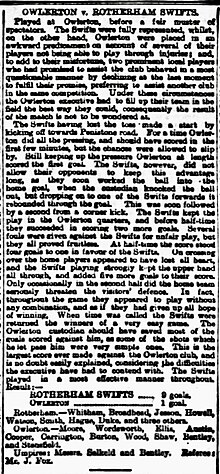The Football Alliance was an association football league in England which ran for three seasons, from 1889–90 to 1891–92.
Sunderland Albion Football Club was an English association football club based in Sunderland, England, formed in 1888. The club played in the Football Alliance, a rival to the Football League, before disbanding in 1892.
Ecclesfield is a village and civil parish in the City of Sheffield, South Yorkshire, England, about 4 miles (6 km) north of Sheffield City Centre. Ecclesfield civil parish had a population of 32,073 at the 2011 Census. Ecclesfield wards of the City of Sheffield had a population of 35,994 in 2011. The population of Ecclesfield village stood at 7,163 in the most recent census.

Worksop Town Football Club is an English football club based in Worksop, Nottinghamshire. The team play in the Northern Premier League Premier Division. They are nicknamed The Tigers and play their home games at Sandy Lane in Worksop.
Birmingham St. George's F.C. was a football club based in Smethwick, England. The club started as St George's FC in Aston, before moving to the Cape Hill brewery in 1886 under the name Mitchell St George's.
Long Eaton Rangers Football Club was a football club based in Long Eaton, Derbyshire, England, which, for a brief period in the 1880s, had a legitimate claim to being one of the best teams in the country. They were founding members of the second ever league, The Combination, in 1888, and when that folded, the Football Alliance in 1889.
The 1889–90 Football Alliance was the first season of the Football Alliance, an association football league which was set up in England as an alternative to The Football League, which had begun in the 1888–89 season. A proposal that the Football League be expanded to 24 teams was rejected, so a new league was formed to cater for those excluded. Twelve clubs were accepted for membership, the same number as in the Football League, and they were drawn from a similar geographical area, stretching from the Midlands to the North West, but also further east in Sheffield, Grimsby and Sunderland.
Notts Rangers Football Club was an English football club, founded in 1868 under the name Nottingham St James. They became Nottingham Rangers in 1880 and by 1886 were habitually referred to as Notts Rangers.
The 1889–90 season was the first in existence for Sheffield United. Having not been elected to any organised league at that point they predominantly played friendly fixtures but did enter the FA Cup for the first time as well as locally arranged cup competitions The Sheffield Challenge Cup and the Wharncliffe Charity Cup. The club did not employ a manager in this period; tactics and team selection were decided by The Football Committee and the players were coached by a trainer. J.B. Wostinholm held the position of club secretary, dealing with player transfers and contracts, arranging matches and dealing with the FA. The first season was deemed a reasonable success with steady attendances to home games and progress in the FA Cup although the fluctuating nature of the team meant that consistency was never really achieved.
The 1890–91 season was Sheffield United's second, and their first and only season playing in the newly formed Midland Counties League, as the club sought to establish itself as a major footballing force. The team was selected by the club's football committee and coached by a trainer, but day-to-day affairs were overseen by club secretary Joseph Wostinholm. The club saw a large influx of players during the season as it continued to bolster its numbers with amateurs loaned or signed from other teams in the local area, a policy that resulted in an unsettled side, indifferent league results, and a mid-table finish.
Staveley F.C. was a football club in Staveley, a village in Derbyshire, England.
Warwick County F.C. was the association football division of Warwickshire County Cricket Club.
The 1892–93 season was the fourth in existence for Sheffield United. This was their first season playing in the recently formed Football League Second Division as the club sought to establish itself as a major footballing force. With some members of the football committee unconvinced of the long-term future of the Football League, the club also retained its membership of the Northern League.
The 1890–91 season was the tenth season of competitive association football played by Small Heath Football Club, an English football club based in the Small Heath district of Birmingham, and their second season in the Football Alliance. They finished in tenth position in the twelve-team league for the second consecutive year. Seven wins, two draws and thirteen defeats gave them sixteen points, one point fewer than in 1889–90. The team scored 58 goals in Alliance competition, but conceded 66, at an average of three goals per match.
The 1889–90 season was the ninth season of competitive association football played by Small Heath F.C., an English football club based in the Small Heath district of Birmingham. They competed in the inaugural season of the Football Alliance. They finished in tenth position in the twelve-team league with six wins, five draws and eleven defeats, which gave them seventeen points. The team scored 44 goals in Alliance competition but conceded 67.
Ecclesfield F.C. was an English association football club based in Ecclesfield, South Yorkshire.
Eckington Works Football Club was an English association football club based in Eckington, Derbyshire.
Halliwell F.C. was an English association football club based in Halliwell, in north-west Bolton.
The Midland Alliance was an association football league for teams in the Midlands of England, which ran for three seasons in the 1890s.

